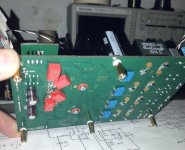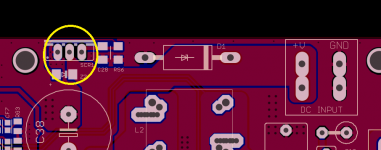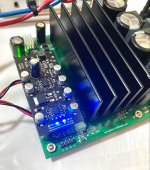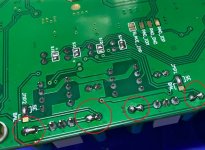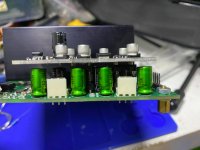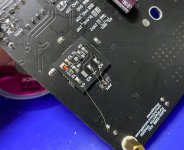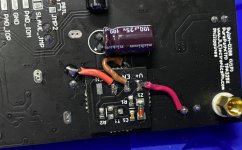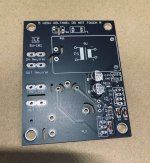Not sure what version of the amp I got from you, but is this buffer board applicable to your earlier amp?Dual Supply Buffer for TICore260BTL is now ready for manufacturing
Uses SOIC-8 dual opamps like OPA1656.
Modification on the main TICore260BTL board: Just short out 4 electro input coupling caps.
D
Deleted member 148505
Hi Tan,
Yes it is applicable. I forgot to mention though that we need right angle connectors for the inputs as the board will block them.
Also some caps might need to be replaced with lower height or be soldered under the PCB. (I saw Brad did it on his board since the caps might be taller than the daughtercard, attached pics from his implementation )
The boards will arrive next week
Regards,
Lester
Yes it is applicable. I forgot to mention though that we need right angle connectors for the inputs as the board will block them.
Also some caps might need to be replaced with lower height or be soldered under the PCB. (I saw Brad did it on his board since the caps might be taller than the daughtercard, attached pics from his implementation )
The boards will arrive next week
Regards,
Lester
Not sure what version of the amp I got from you, but is this buffer board applicable to your earlier amp?
Attachments
D
Deleted member 148505
Erratum, the daughtercard can be raised higher, so that it won't block or hinder any motherboard parts. I'll show how it will be doneI forgot to mention though that we need right angle connectors for the inputs as the board will block them.
Also some caps might need to be replaced with lower height or be soldered under the PCB.

D
Deleted member 148505
I tested the overvoltage protection (changed zener diode to lower value) and reverse voltage protection in TICore260BTL, for power supplies with robust protection like LRS-350-36 and SMPS300RS, it is working as expected, reverse protection and overvoltage protection works.
But when I tried it on my generic meanwell chinese clone, the copper trace in the PCB SCR area went poof and acted like a fuse (attached pic). No damage on either the SMPS or the TPA3255 module since the voltage that I tested it on is below TPA3255's max voltage. (looks like OCP on cheap smps is not implemented on its output and only relies on mains fuse, when the pcb trace went busted, overcurrent stopped and saved the smps)
So in the latest Sylph-D200 version V1P, I thickened out the said trace. I haven't tested it in my chinese meanwell clone though since the SMPS might get busted lol.
But when I tried it on my generic meanwell chinese clone, the copper trace in the PCB SCR area went poof and acted like a fuse (attached pic). No damage on either the SMPS or the TPA3255 module since the voltage that I tested it on is below TPA3255's max voltage. (looks like OCP on cheap smps is not implemented on its output and only relies on mains fuse, when the pcb trace went busted, overcurrent stopped and saved the smps)
So in the latest Sylph-D200 version V1P, I thickened out the said trace. I haven't tested it in my chinese meanwell clone though since the SMPS might get busted lol.
Attachments
Last edited by a moderator:
D
Deleted member 148505
Moment of truth...
It is working! . I don't have TO-92 LM337 here so I bypassed it for testing.
. I don't have TO-92 LM337 here so I bypassed it for testing.
Final voltage for the opamps will be +/- 6.5V DC
Just short out the input coupling caps in the front to get the full potential.
No slow ramp problem, fix is already integrated.
It is working!
Final voltage for the opamps will be +/- 6.5V DC
Just short out the input coupling caps in the front to get the full potential.
No slow ramp problem, fix is already integrated.
Attachments
D
Deleted member 148505
D
Deleted member 148505
D
Deleted member 148505
TICore260BTL Dual Supply Buffer Price
TICore260BTL DS Buffer with 2pcs OPA1656 price for TICore260BTL users is 16 USD
+ Shipping fee, Max 100g, can ship around 3 to 4pcs per parcel.
USA = 15 USD
Australia = 18 USD
France = 9.5 USD
Germany = 8.5 USD
New Zealand = 11.5 USD
UK = 9.5 USD
Rest of the World = 15 USD
TICore260BTL DS Buffer with 2pcs OPA1656 price for TICore260BTL users is 16 USD
+ Shipping fee, Max 100g, can ship around 3 to 4pcs per parcel.
USA = 15 USD
Australia = 18 USD
France = 9.5 USD
Germany = 8.5 USD
New Zealand = 11.5 USD
UK = 9.5 USD
Rest of the World = 15 USD
Attachments
Last edited by a moderator:
D
Deleted member 148505
So how do we order Lester?
We will start shipping out the items on July 1st. We can combine up to 4pcs per parcel or shipping fee will increase if the weight is greater than 100g.
Please send payment to sales@jlelectronicsph.com or we can create an invoice for you. Also please add 4.7% on top of total payment for the PayPal fee. Thanks!
D
Deleted member 148505
Specs on the buffer? What is the input sensitivity with the combo?
Buffer is unity gain and uses the same circuitry as the original.
D
Deleted member 148505
I need to drill the chassis to mount my TICore260BTL - is there a mechanical drawing available?
Please email to support@jlelectronicsph.com, thanks!
Buffer is unity gain and uses the same circuitry as the original.Input sensitivity is 1.3Vrms in non-PFFB mode.
I did most of the work to install my TICore260BTL and SMPS600RS modules into a chassis over the weekend - just need to finalise the mains supply wiring to the SMPS and install some phono sockets to complete the build. I had it playing music with the new SMPS - all worked very well except I was playing with my passive attenuator at, or about, maximum and could have done with a little more volume.
My TICore260BTL is a standard built and I use single-ended inputs - my sources are all about 1Vrms output so an input sensitivity of 2.5Vrms is a bit limiting - how can I increase the input sensitivity with single-ended input?
D
Deleted member 148505
I did most of the work to install my TICore260BTL and SMPS600RS modules into a chassis over the weekend - just need to finalise the mains supply wiring to the SMPS and install some phono sockets to complete the build. I had it playing music with the new SMPS - all worked very well except I was playing with my passive attenuator at, or about, maximum and could have done with a little more volume.
My TICore260BTL is a standard built and I use single-ended inputs - my sources are all about 1Vrms output so an input sensitivity of 2.5Vrms is a bit limiting - how can I increase the input sensitivity with single-ended input?
Hi, you can't change the gain since the opamps are using single supply configuration, it'll have an issue with stability because DC offset (if there's any) will be amplified by the next opamp stage.
You need to disable PFFB to get the gain back.
You can change the gain of the opamps once you receive the split supply daughtercard module, you need 15K 0603 resistors (I'll check if I have a stock here)
Regards,
Lester
D
Deleted member 148505
Thanks Lester. I interpret that as my best strategy being to do nothing until I get the new buffer (i.e. leave PFFB enabled and increase the gain with the new buffer) - do I have that right?
Ray
You can disable PFFB now to increase the gain while waiting for your new buffer.
Wick out solder jumpers under the input coupling caps near the heatsink.
What's your attenuators impedance?
Brrt. So you can only change system gain by modifying the main amp board, and by replacing resistors at that?Buffer is unity gain and uses the same circuitry as the original.Input sensitivity is 1.3Vrms in non-PFFB mode.
I thought the buffer would be a good opportunity to make easy changes to gain. Perhaps two versions, one for unity gain (existing) and one for high gain, so that max power can be achieved with balanced input 1.5-2.0 Vrms.
D
Deleted member 148505
Brrt. So you can only change system gain by modifying the main amp board, and by replacing resistors at that?
I thought the buffer would be a good opportunity to make easy changes to gain. Perhaps two versions, one for unity gain (existing) and one for high gain, so that max power can be achieved with balanced input 1.5-2.0 Vrms.
I designed the buffer such that there will be minimal changes needed for existing TICore260BTL boards. Only shorting out the 4 input coupling caps is required (and the main purpose of it).
Side benefit is that we can now increase the gain without stability issues.
Regards,
Lester
Last edited by a moderator:
- Status
- Not open for further replies.
- Home
- Vendor's Bazaar
- Amplifier Modules and PCBs For Sale

